Developing a Lesson Plan to Meet Diverse Individual Needs
VerifiedAdded on 2023/06/14
|24
|5709
|238
Report
AI Summary
This report provides a comprehensive overview of lesson planning, emphasizing the importance of meeting individual learning needs and creating inclusive learning environments. It covers various aspects of lesson plan design, including defining aims, incorporating learning styles (VARK), and utilizing taxonomies like Fink’s to enhance learning experiences. The report also addresses the need for flexibility and adaptability in lesson plans to accommodate diverse learners and changing demands. Furthermore, it discusses assessment and evaluation methods, including differentiated assessments, to monitor student progress and inform future lesson planning. The report includes a sample lesson plan for mathematics and highlights the significance of student feedback in refining teaching strategies, ensuring that lesson plans are tailored to promote effective and inclusive learning for all students. Desklib provides a platform for students to access similar solved assignments and study tools.

Lesson Planning
Paraphrase This Document
Need a fresh take? Get an instant paraphrase of this document with our AI Paraphraser
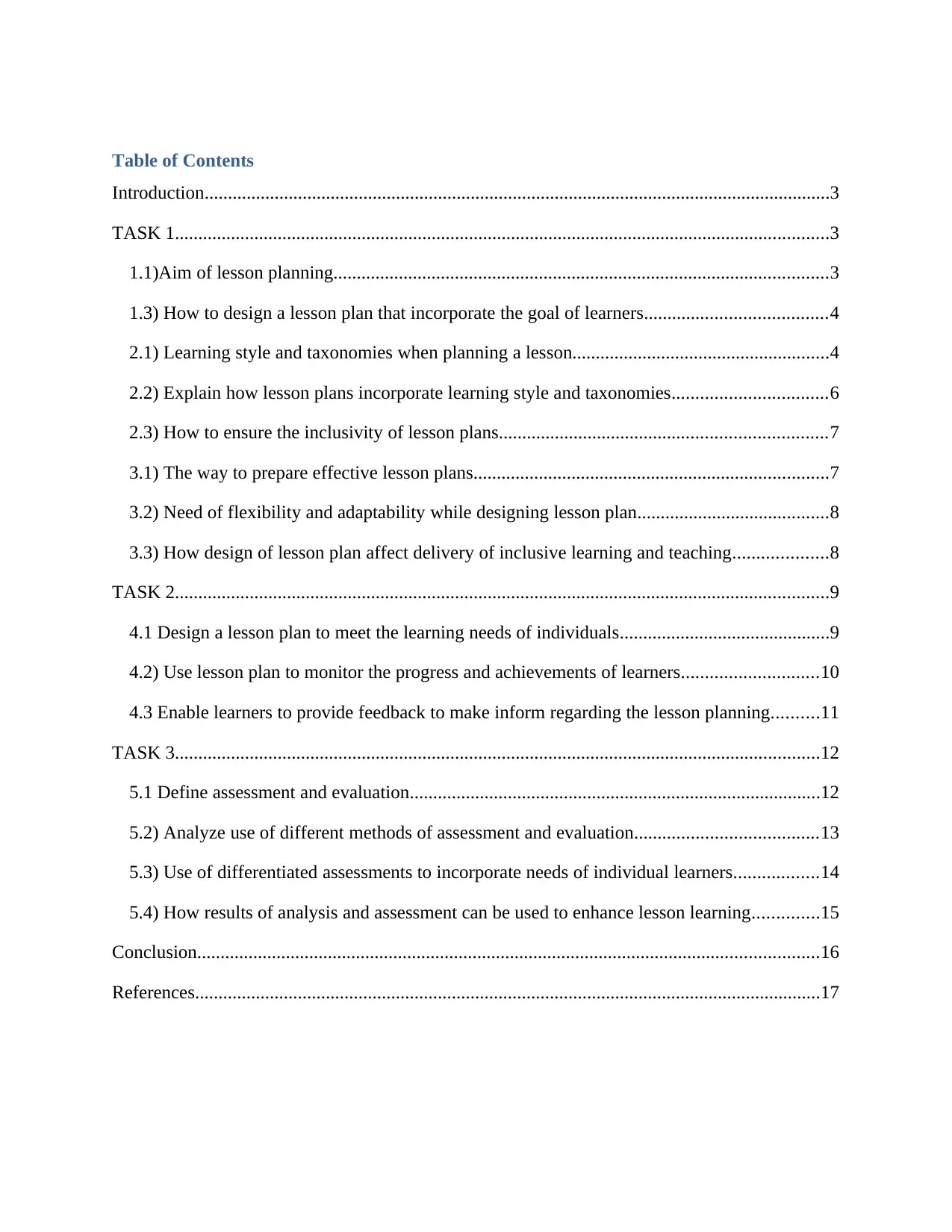
Table of Contents
Introduction......................................................................................................................................3
TASK 1............................................................................................................................................3
1.1)Aim of lesson planning..........................................................................................................3
1.3) How to design a lesson plan that incorporate the goal of learners.......................................4
2.1) Learning style and taxonomies when planning a lesson.......................................................4
2.2) Explain how lesson plans incorporate learning style and taxonomies.................................6
2.3) How to ensure the inclusivity of lesson plans......................................................................7
3.1) The way to prepare effective lesson plans............................................................................7
3.2) Need of flexibility and adaptability while designing lesson plan.........................................8
3.3) How design of lesson plan affect delivery of inclusive learning and teaching....................8
TASK 2............................................................................................................................................9
4.1 Design a lesson plan to meet the learning needs of individuals.............................................9
4.2) Use lesson plan to monitor the progress and achievements of learners.............................10
4.3 Enable learners to provide feedback to make inform regarding the lesson planning..........11
TASK 3..........................................................................................................................................12
5.1 Define assessment and evaluation........................................................................................12
5.2) Analyze use of different methods of assessment and evaluation.......................................13
5.3) Use of differentiated assessments to incorporate needs of individual learners..................14
5.4) How results of analysis and assessment can be used to enhance lesson learning..............15
Conclusion.....................................................................................................................................16
References......................................................................................................................................17
Introduction......................................................................................................................................3
TASK 1............................................................................................................................................3
1.1)Aim of lesson planning..........................................................................................................3
1.3) How to design a lesson plan that incorporate the goal of learners.......................................4
2.1) Learning style and taxonomies when planning a lesson.......................................................4
2.2) Explain how lesson plans incorporate learning style and taxonomies.................................6
2.3) How to ensure the inclusivity of lesson plans......................................................................7
3.1) The way to prepare effective lesson plans............................................................................7
3.2) Need of flexibility and adaptability while designing lesson plan.........................................8
3.3) How design of lesson plan affect delivery of inclusive learning and teaching....................8
TASK 2............................................................................................................................................9
4.1 Design a lesson plan to meet the learning needs of individuals.............................................9
4.2) Use lesson plan to monitor the progress and achievements of learners.............................10
4.3 Enable learners to provide feedback to make inform regarding the lesson planning..........11
TASK 3..........................................................................................................................................12
5.1 Define assessment and evaluation........................................................................................12
5.2) Analyze use of different methods of assessment and evaluation.......................................13
5.3) Use of differentiated assessments to incorporate needs of individual learners..................14
5.4) How results of analysis and assessment can be used to enhance lesson learning..............15
Conclusion.....................................................................................................................................16
References......................................................................................................................................17
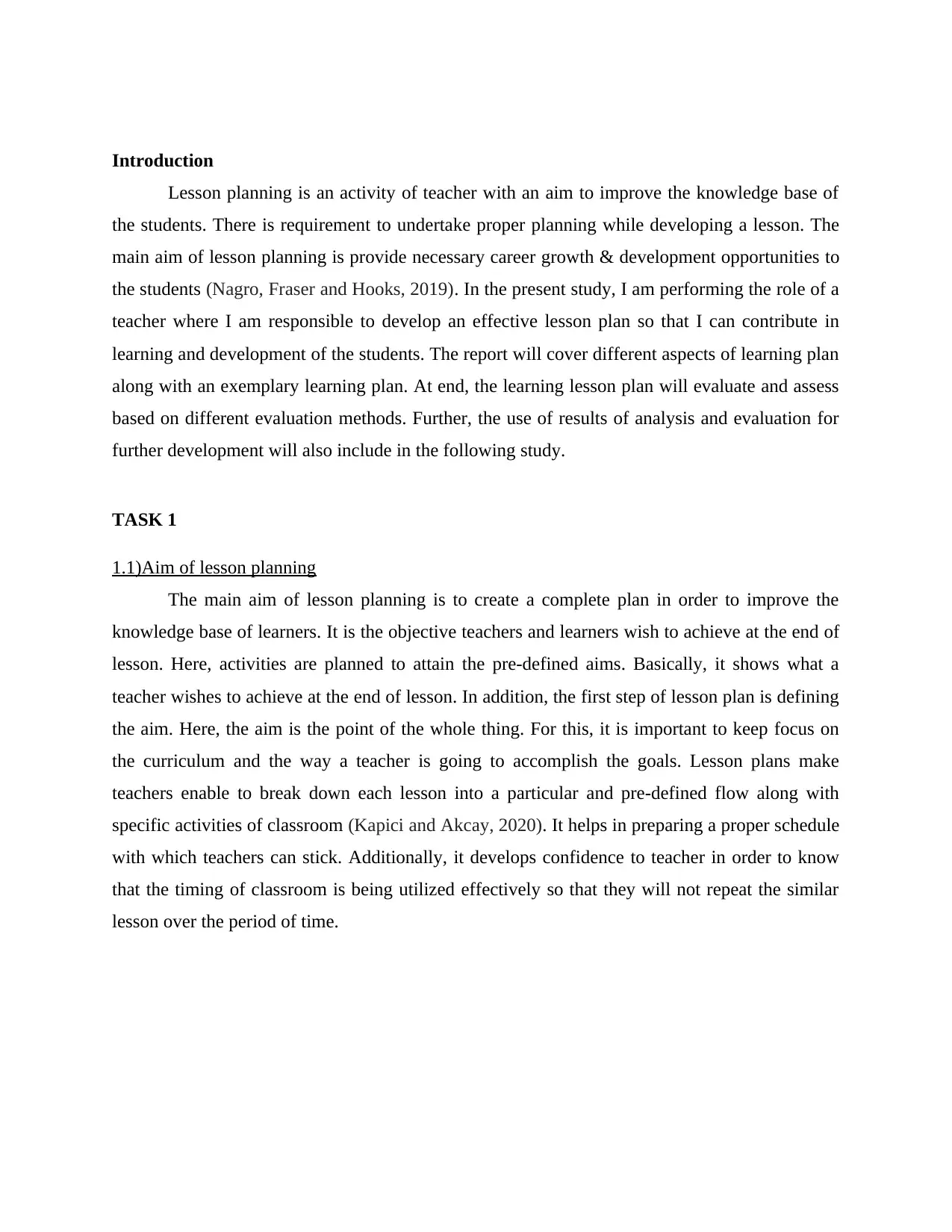
Introduction
Lesson planning is an activity of teacher with an aim to improve the knowledge base of
the students. There is requirement to undertake proper planning while developing a lesson. The
main aim of lesson planning is provide necessary career growth & development opportunities to
the students (Nagro, Fraser and Hooks, 2019). In the present study, I am performing the role of a
teacher where I am responsible to develop an effective lesson plan so that I can contribute in
learning and development of the students. The report will cover different aspects of learning plan
along with an exemplary learning plan. At end, the learning lesson plan will evaluate and assess
based on different evaluation methods. Further, the use of results of analysis and evaluation for
further development will also include in the following study.
TASK 1
1.1)Aim of lesson planning
The main aim of lesson planning is to create a complete plan in order to improve the
knowledge base of learners. It is the objective teachers and learners wish to achieve at the end of
lesson. Here, activities are planned to attain the pre-defined aims. Basically, it shows what a
teacher wishes to achieve at the end of lesson. In addition, the first step of lesson plan is defining
the aim. Here, the aim is the point of the whole thing. For this, it is important to keep focus on
the curriculum and the way a teacher is going to accomplish the goals. Lesson plans make
teachers enable to break down each lesson into a particular and pre-defined flow along with
specific activities of classroom (Kapici and Akcay, 2020). It helps in preparing a proper schedule
with which teachers can stick. Additionally, it develops confidence to teacher in order to know
that the timing of classroom is being utilized effectively so that they will not repeat the similar
lesson over the period of time.
Lesson planning is an activity of teacher with an aim to improve the knowledge base of
the students. There is requirement to undertake proper planning while developing a lesson. The
main aim of lesson planning is provide necessary career growth & development opportunities to
the students (Nagro, Fraser and Hooks, 2019). In the present study, I am performing the role of a
teacher where I am responsible to develop an effective lesson plan so that I can contribute in
learning and development of the students. The report will cover different aspects of learning plan
along with an exemplary learning plan. At end, the learning lesson plan will evaluate and assess
based on different evaluation methods. Further, the use of results of analysis and evaluation for
further development will also include in the following study.
TASK 1
1.1)Aim of lesson planning
The main aim of lesson planning is to create a complete plan in order to improve the
knowledge base of learners. It is the objective teachers and learners wish to achieve at the end of
lesson. Here, activities are planned to attain the pre-defined aims. Basically, it shows what a
teacher wishes to achieve at the end of lesson. In addition, the first step of lesson plan is defining
the aim. Here, the aim is the point of the whole thing. For this, it is important to keep focus on
the curriculum and the way a teacher is going to accomplish the goals. Lesson plans make
teachers enable to break down each lesson into a particular and pre-defined flow along with
specific activities of classroom (Kapici and Akcay, 2020). It helps in preparing a proper schedule
with which teachers can stick. Additionally, it develops confidence to teacher in order to know
that the timing of classroom is being utilized effectively so that they will not repeat the similar
lesson over the period of time.
⊘ This is a preview!⊘
Do you want full access?
Subscribe today to unlock all pages.

Trusted by 1+ million students worldwide
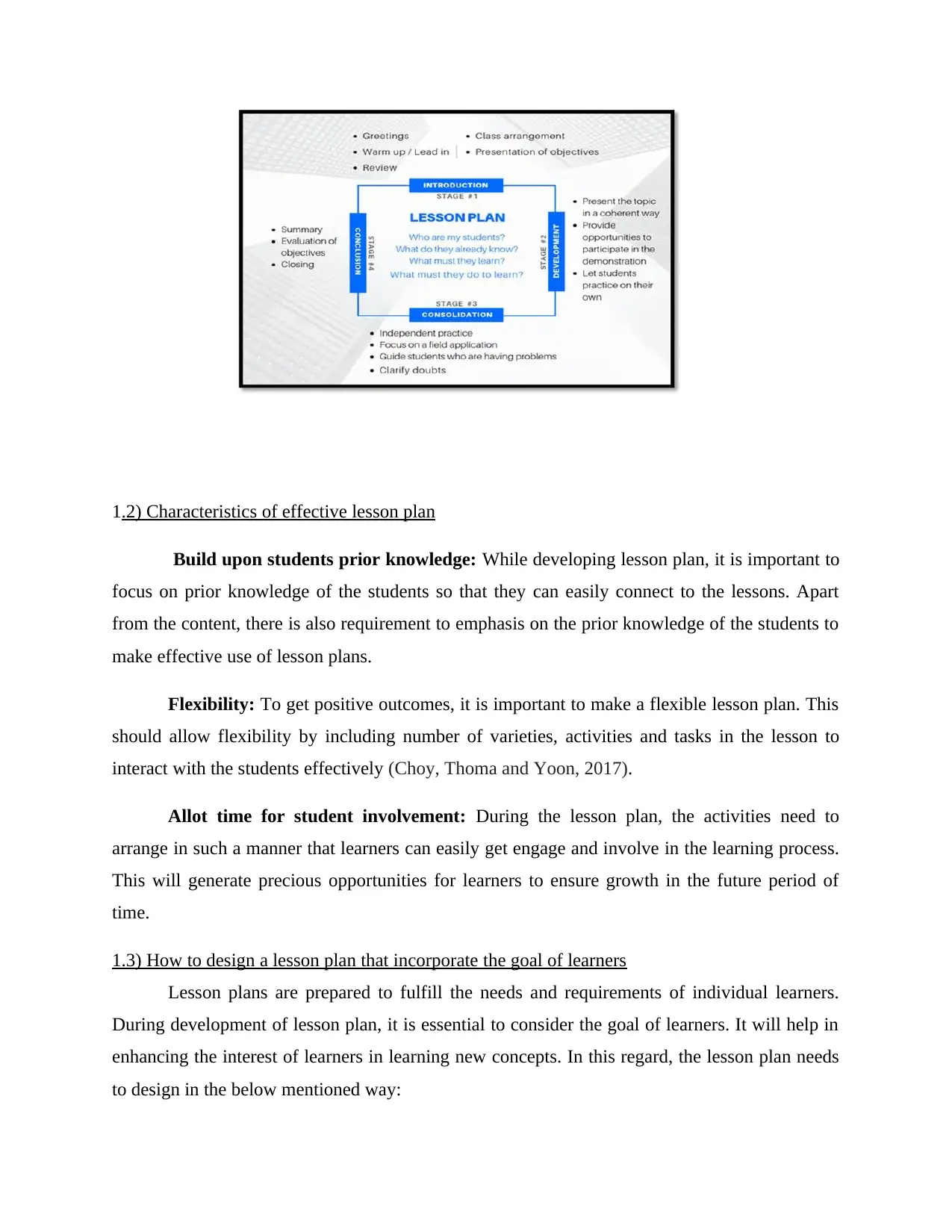
1.2) Characteristics of effective lesson plan
Build upon students prior knowledge: While developing lesson plan, it is important to
focus on prior knowledge of the students so that they can easily connect to the lessons. Apart
from the content, there is also requirement to emphasis on the prior knowledge of the students to
make effective use of lesson plans.
Flexibility: To get positive outcomes, it is important to make a flexible lesson plan. This
should allow flexibility by including number of varieties, activities and tasks in the lesson to
interact with the students effectively (Choy, Thoma and Yoon, 2017).
Allot time for student involvement: During the lesson plan, the activities need to
arrange in such a manner that learners can easily get engage and involve in the learning process.
This will generate precious opportunities for learners to ensure growth in the future period of
time.
1.3) How to design a lesson plan that incorporate the goal of learners
Lesson plans are prepared to fulfill the needs and requirements of individual learners.
During development of lesson plan, it is essential to consider the goal of learners. It will help in
enhancing the interest of learners in learning new concepts. In this regard, the lesson plan needs
to design in the below mentioned way:
Build upon students prior knowledge: While developing lesson plan, it is important to
focus on prior knowledge of the students so that they can easily connect to the lessons. Apart
from the content, there is also requirement to emphasis on the prior knowledge of the students to
make effective use of lesson plans.
Flexibility: To get positive outcomes, it is important to make a flexible lesson plan. This
should allow flexibility by including number of varieties, activities and tasks in the lesson to
interact with the students effectively (Choy, Thoma and Yoon, 2017).
Allot time for student involvement: During the lesson plan, the activities need to
arrange in such a manner that learners can easily get engage and involve in the learning process.
This will generate precious opportunities for learners to ensure growth in the future period of
time.
1.3) How to design a lesson plan that incorporate the goal of learners
Lesson plans are prepared to fulfill the needs and requirements of individual learners.
During development of lesson plan, it is essential to consider the goal of learners. It will help in
enhancing the interest of learners in learning new concepts. In this regard, the lesson plan needs
to design in the below mentioned way:
Paraphrase This Document
Need a fresh take? Get an instant paraphrase of this document with our AI Paraphraser
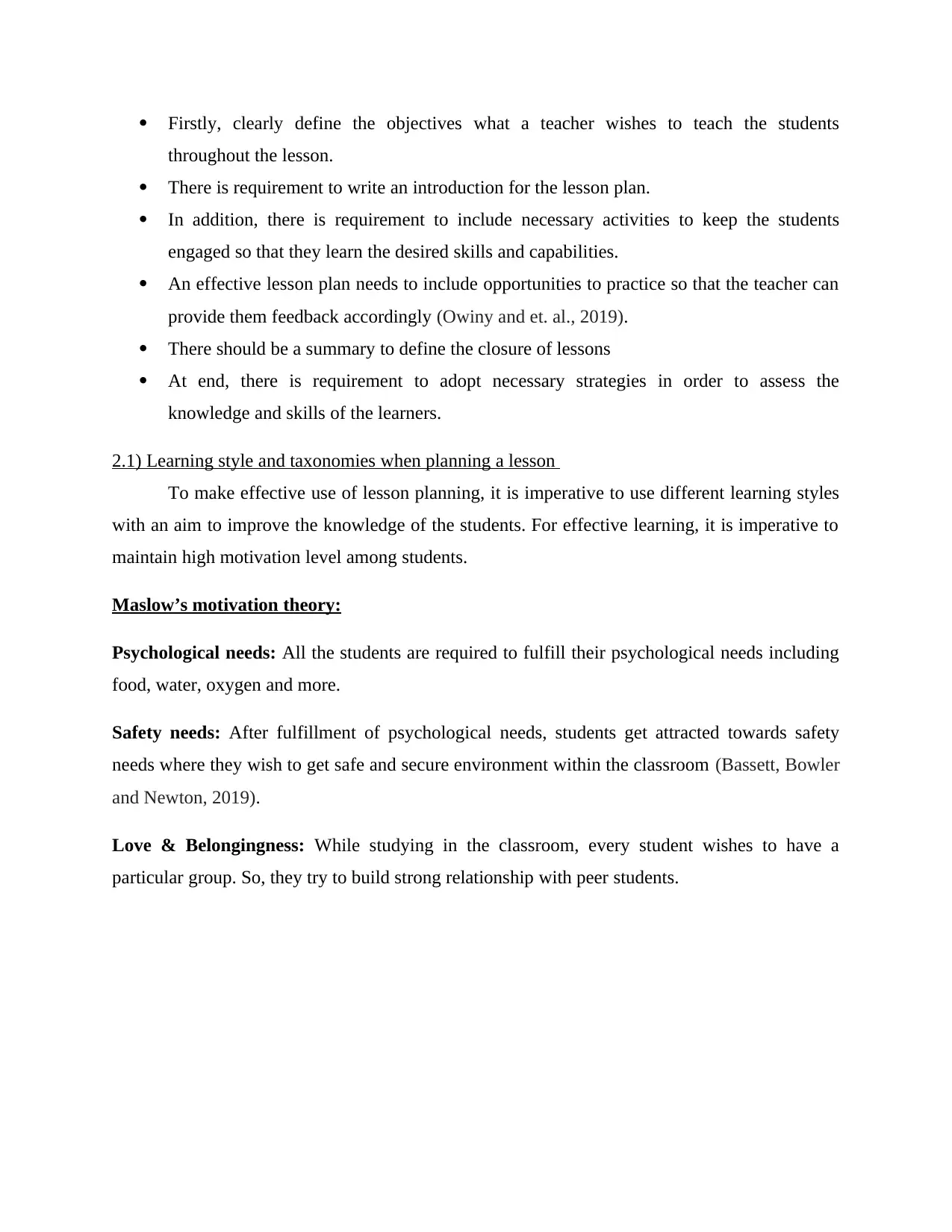
Firstly, clearly define the objectives what a teacher wishes to teach the students
throughout the lesson.
There is requirement to write an introduction for the lesson plan.
In addition, there is requirement to include necessary activities to keep the students
engaged so that they learn the desired skills and capabilities.
An effective lesson plan needs to include opportunities to practice so that the teacher can
provide them feedback accordingly (Owiny and et. al., 2019).
There should be a summary to define the closure of lessons
At end, there is requirement to adopt necessary strategies in order to assess the
knowledge and skills of the learners.
2.1) Learning style and taxonomies when planning a lesson
To make effective use of lesson planning, it is imperative to use different learning styles
with an aim to improve the knowledge of the students. For effective learning, it is imperative to
maintain high motivation level among students.
Maslow’s motivation theory:
Psychological needs: All the students are required to fulfill their psychological needs including
food, water, oxygen and more.
Safety needs: After fulfillment of psychological needs, students get attracted towards safety
needs where they wish to get safe and secure environment within the classroom (Bassett, Bowler
and Newton, 2019).
Love & Belongingness: While studying in the classroom, every student wishes to have a
particular group. So, they try to build strong relationship with peer students.
throughout the lesson.
There is requirement to write an introduction for the lesson plan.
In addition, there is requirement to include necessary activities to keep the students
engaged so that they learn the desired skills and capabilities.
An effective lesson plan needs to include opportunities to practice so that the teacher can
provide them feedback accordingly (Owiny and et. al., 2019).
There should be a summary to define the closure of lessons
At end, there is requirement to adopt necessary strategies in order to assess the
knowledge and skills of the learners.
2.1) Learning style and taxonomies when planning a lesson
To make effective use of lesson planning, it is imperative to use different learning styles
with an aim to improve the knowledge of the students. For effective learning, it is imperative to
maintain high motivation level among students.
Maslow’s motivation theory:
Psychological needs: All the students are required to fulfill their psychological needs including
food, water, oxygen and more.
Safety needs: After fulfillment of psychological needs, students get attracted towards safety
needs where they wish to get safe and secure environment within the classroom (Bassett, Bowler
and Newton, 2019).
Love & Belongingness: While studying in the classroom, every student wishes to have a
particular group. So, they try to build strong relationship with peer students.
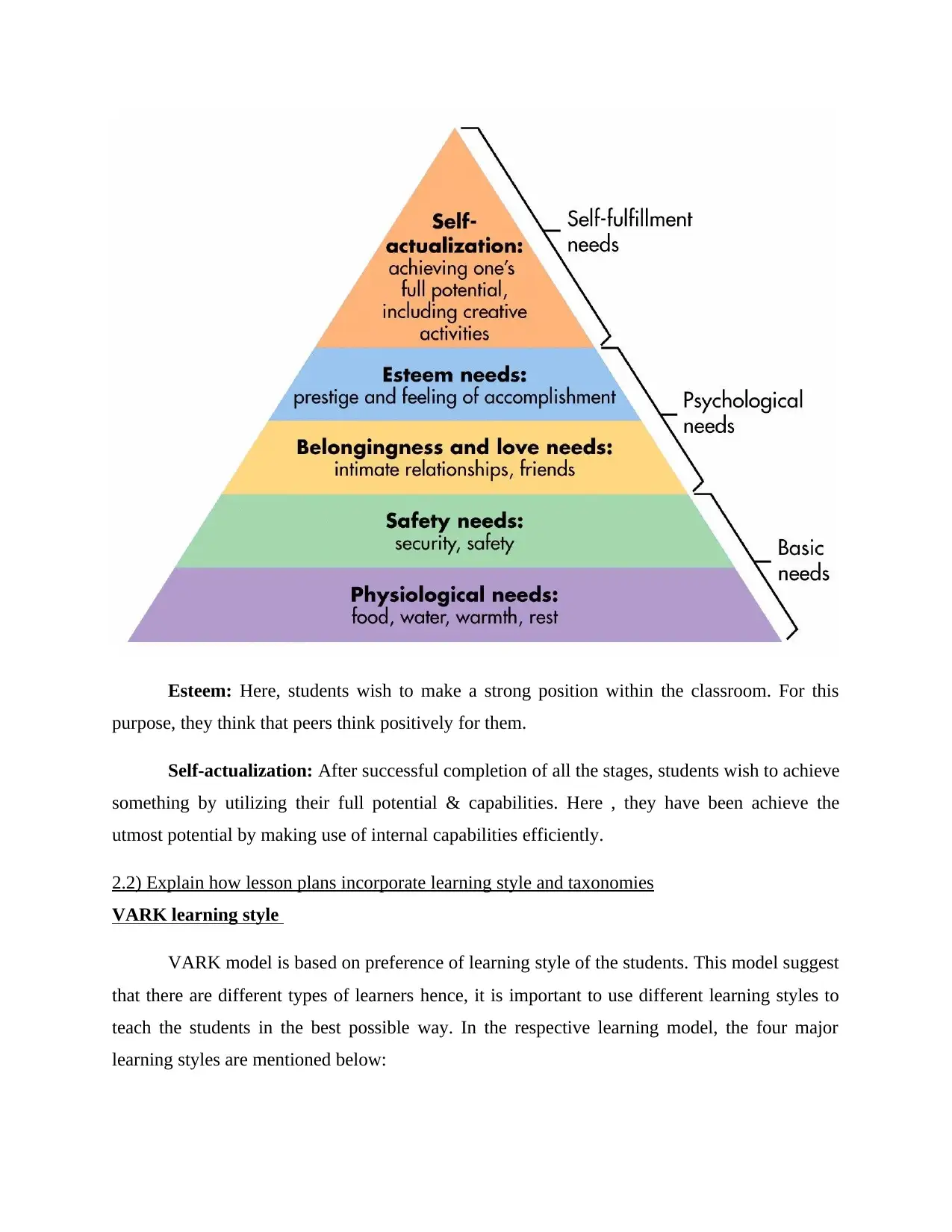
Esteem: Here, students wish to make a strong position within the classroom. For this
purpose, they think that peers think positively for them.
Self-actualization: After successful completion of all the stages, students wish to achieve
something by utilizing their full potential & capabilities. Here , they have been achieve the
utmost potential by making use of internal capabilities efficiently.
2.2) Explain how lesson plans incorporate learning style and taxonomies
VARK learning style
VARK model is based on preference of learning style of the students. This model suggest
that there are different types of learners hence, it is important to use different learning styles to
teach the students in the best possible way. In the respective learning model, the four major
learning styles are mentioned below:
purpose, they think that peers think positively for them.
Self-actualization: After successful completion of all the stages, students wish to achieve
something by utilizing their full potential & capabilities. Here , they have been achieve the
utmost potential by making use of internal capabilities efficiently.
2.2) Explain how lesson plans incorporate learning style and taxonomies
VARK learning style
VARK model is based on preference of learning style of the students. This model suggest
that there are different types of learners hence, it is important to use different learning styles to
teach the students in the best possible way. In the respective learning model, the four major
learning styles are mentioned below:
⊘ This is a preview!⊘
Do you want full access?
Subscribe today to unlock all pages.

Trusted by 1+ million students worldwide
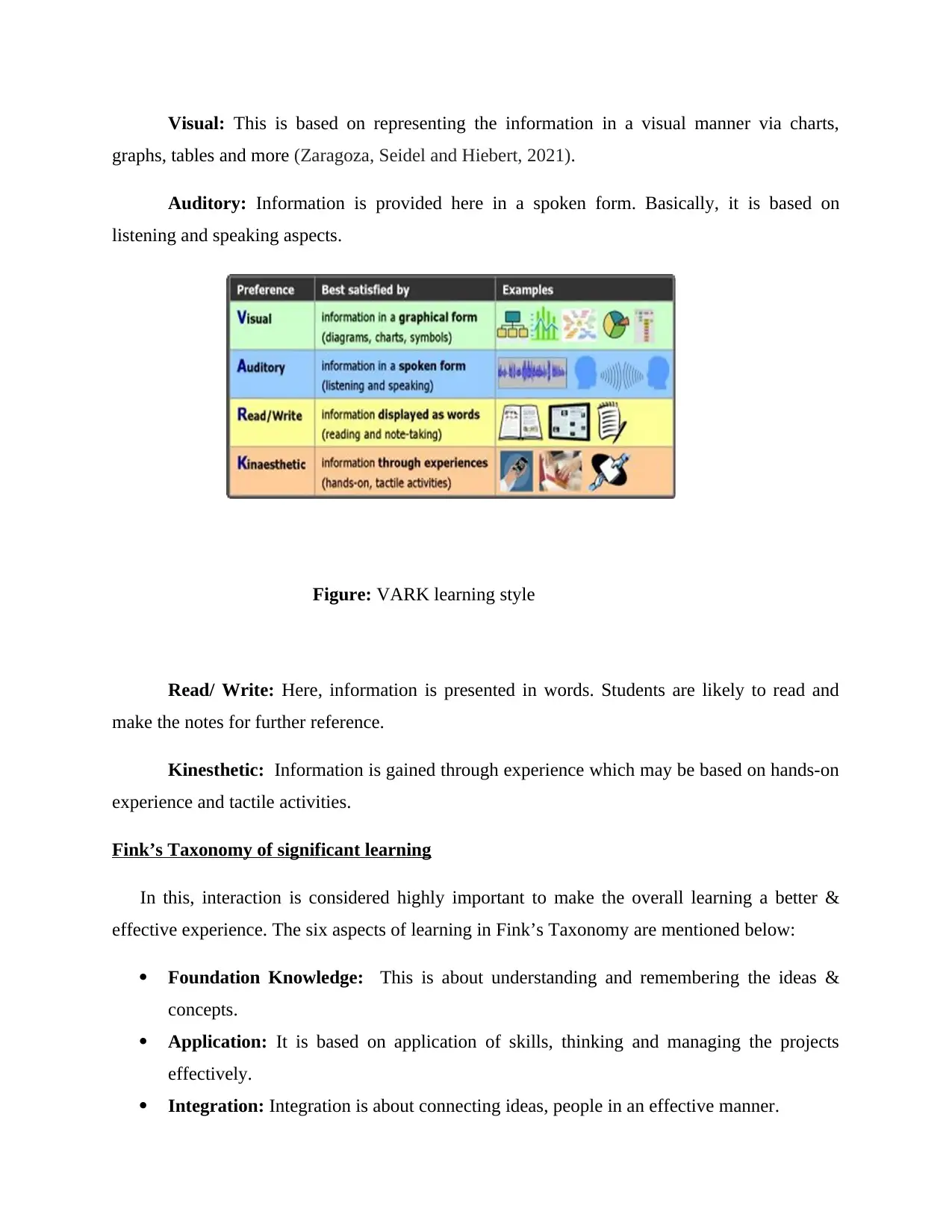
Visual: This is based on representing the information in a visual manner via charts,
graphs, tables and more (Zaragoza, Seidel and Hiebert, 2021).
Auditory: Information is provided here in a spoken form. Basically, it is based on
listening and speaking aspects.
Figure: VARK learning style
Read/ Write: Here, information is presented in words. Students are likely to read and
make the notes for further reference.
Kinesthetic: Information is gained through experience which may be based on hands-on
experience and tactile activities.
Fink’s Taxonomy of significant learning
In this, interaction is considered highly important to make the overall learning a better &
effective experience. The six aspects of learning in Fink’s Taxonomy are mentioned below:
Foundation Knowledge: This is about understanding and remembering the ideas &
concepts.
Application: It is based on application of skills, thinking and managing the projects
effectively.
Integration: Integration is about connecting ideas, people in an effective manner.
graphs, tables and more (Zaragoza, Seidel and Hiebert, 2021).
Auditory: Information is provided here in a spoken form. Basically, it is based on
listening and speaking aspects.
Figure: VARK learning style
Read/ Write: Here, information is presented in words. Students are likely to read and
make the notes for further reference.
Kinesthetic: Information is gained through experience which may be based on hands-on
experience and tactile activities.
Fink’s Taxonomy of significant learning
In this, interaction is considered highly important to make the overall learning a better &
effective experience. The six aspects of learning in Fink’s Taxonomy are mentioned below:
Foundation Knowledge: This is about understanding and remembering the ideas &
concepts.
Application: It is based on application of skills, thinking and managing the projects
effectively.
Integration: Integration is about connecting ideas, people in an effective manner.
Paraphrase This Document
Need a fresh take? Get an instant paraphrase of this document with our AI Paraphraser
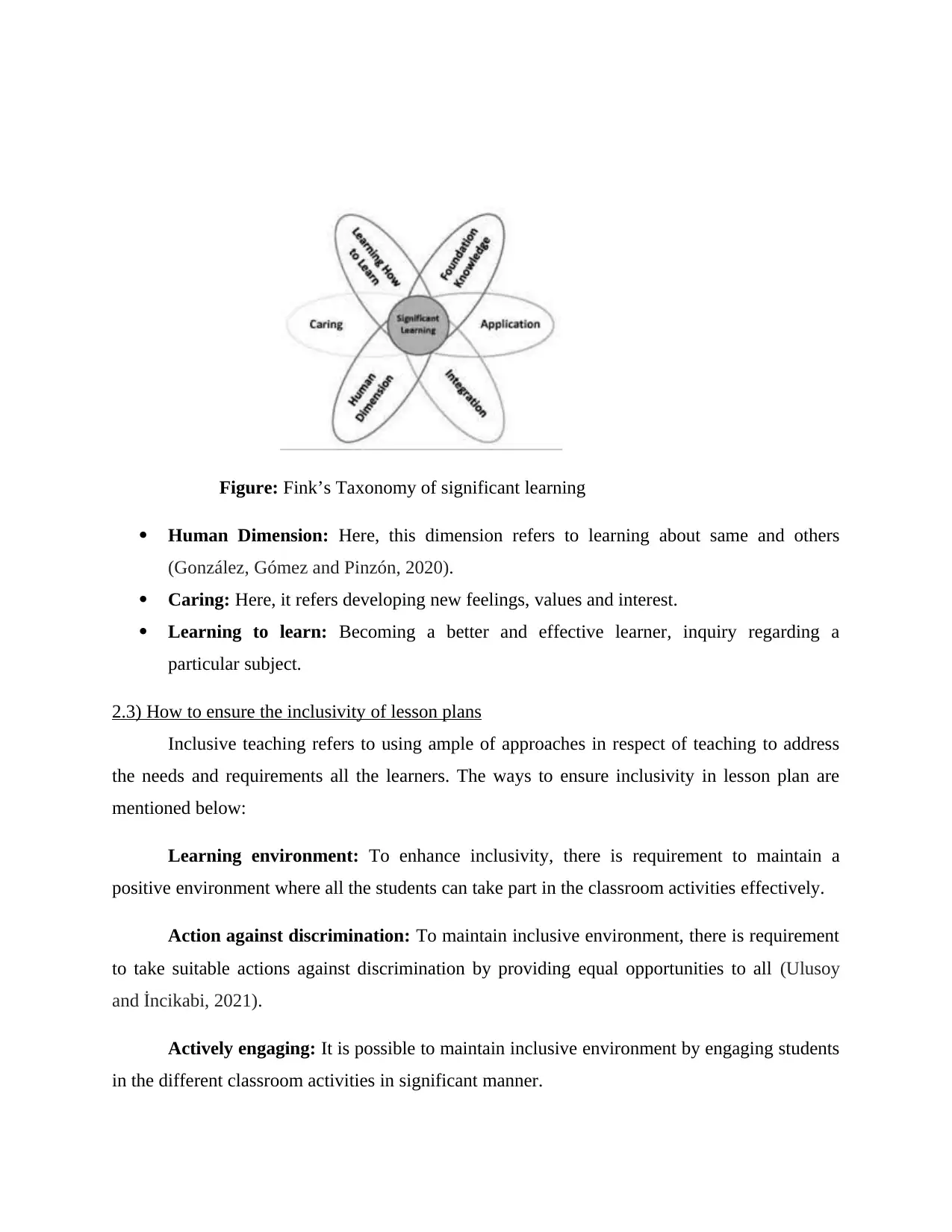
Figure: Fink’s Taxonomy of significant learning
Human Dimension: Here, this dimension refers to learning about same and others
(González, Gómez and Pinzón, 2020).
Caring: Here, it refers developing new feelings, values and interest.
Learning to learn: Becoming a better and effective learner, inquiry regarding a
particular subject.
2.3) How to ensure the inclusivity of lesson plans
Inclusive teaching refers to using ample of approaches in respect of teaching to address
the needs and requirements all the learners. The ways to ensure inclusivity in lesson plan are
mentioned below:
Learning environment: To enhance inclusivity, there is requirement to maintain a
positive environment where all the students can take part in the classroom activities effectively.
Action against discrimination: To maintain inclusive environment, there is requirement
to take suitable actions against discrimination by providing equal opportunities to all (Ulusoy
and İncikabi, 2021).
Actively engaging: It is possible to maintain inclusive environment by engaging students
in the different classroom activities in significant manner.
Human Dimension: Here, this dimension refers to learning about same and others
(González, Gómez and Pinzón, 2020).
Caring: Here, it refers developing new feelings, values and interest.
Learning to learn: Becoming a better and effective learner, inquiry regarding a
particular subject.
2.3) How to ensure the inclusivity of lesson plans
Inclusive teaching refers to using ample of approaches in respect of teaching to address
the needs and requirements all the learners. The ways to ensure inclusivity in lesson plan are
mentioned below:
Learning environment: To enhance inclusivity, there is requirement to maintain a
positive environment where all the students can take part in the classroom activities effectively.
Action against discrimination: To maintain inclusive environment, there is requirement
to take suitable actions against discrimination by providing equal opportunities to all (Ulusoy
and İncikabi, 2021).
Actively engaging: It is possible to maintain inclusive environment by engaging students
in the different classroom activities in significant manner.
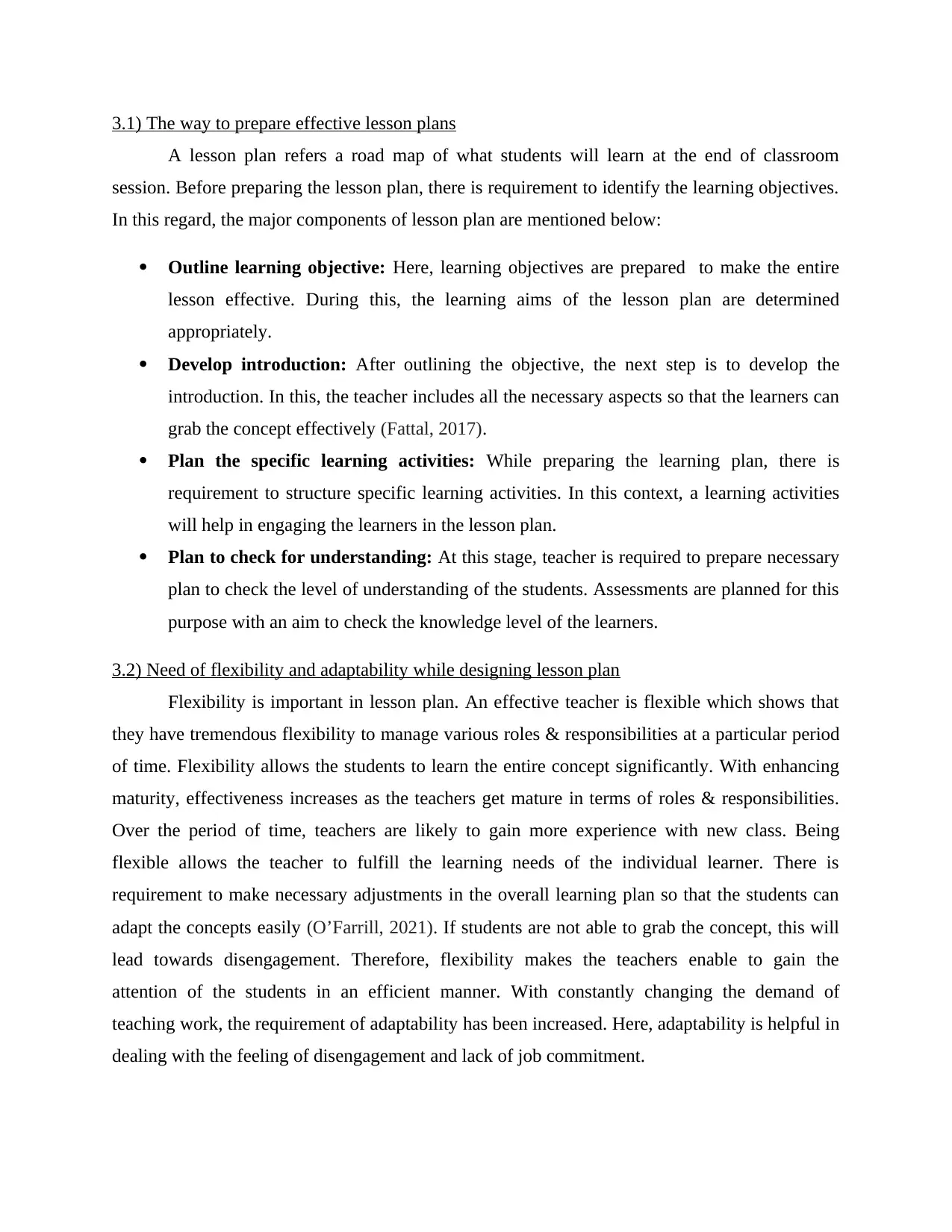
3.1) The way to prepare effective lesson plans
A lesson plan refers a road map of what students will learn at the end of classroom
session. Before preparing the lesson plan, there is requirement to identify the learning objectives.
In this regard, the major components of lesson plan are mentioned below:
Outline learning objective: Here, learning objectives are prepared to make the entire
lesson effective. During this, the learning aims of the lesson plan are determined
appropriately.
Develop introduction: After outlining the objective, the next step is to develop the
introduction. In this, the teacher includes all the necessary aspects so that the learners can
grab the concept effectively (Fattal, 2017).
Plan the specific learning activities: While preparing the learning plan, there is
requirement to structure specific learning activities. In this context, a learning activities
will help in engaging the learners in the lesson plan.
Plan to check for understanding: At this stage, teacher is required to prepare necessary
plan to check the level of understanding of the students. Assessments are planned for this
purpose with an aim to check the knowledge level of the learners.
3.2) Need of flexibility and adaptability while designing lesson plan
Flexibility is important in lesson plan. An effective teacher is flexible which shows that
they have tremendous flexibility to manage various roles & responsibilities at a particular period
of time. Flexibility allows the students to learn the entire concept significantly. With enhancing
maturity, effectiveness increases as the teachers get mature in terms of roles & responsibilities.
Over the period of time, teachers are likely to gain more experience with new class. Being
flexible allows the teacher to fulfill the learning needs of the individual learner. There is
requirement to make necessary adjustments in the overall learning plan so that the students can
adapt the concepts easily (O’Farrill, 2021). If students are not able to grab the concept, this will
lead towards disengagement. Therefore, flexibility makes the teachers enable to gain the
attention of the students in an efficient manner. With constantly changing the demand of
teaching work, the requirement of adaptability has been increased. Here, adaptability is helpful in
dealing with the feeling of disengagement and lack of job commitment.
A lesson plan refers a road map of what students will learn at the end of classroom
session. Before preparing the lesson plan, there is requirement to identify the learning objectives.
In this regard, the major components of lesson plan are mentioned below:
Outline learning objective: Here, learning objectives are prepared to make the entire
lesson effective. During this, the learning aims of the lesson plan are determined
appropriately.
Develop introduction: After outlining the objective, the next step is to develop the
introduction. In this, the teacher includes all the necessary aspects so that the learners can
grab the concept effectively (Fattal, 2017).
Plan the specific learning activities: While preparing the learning plan, there is
requirement to structure specific learning activities. In this context, a learning activities
will help in engaging the learners in the lesson plan.
Plan to check for understanding: At this stage, teacher is required to prepare necessary
plan to check the level of understanding of the students. Assessments are planned for this
purpose with an aim to check the knowledge level of the learners.
3.2) Need of flexibility and adaptability while designing lesson plan
Flexibility is important in lesson plan. An effective teacher is flexible which shows that
they have tremendous flexibility to manage various roles & responsibilities at a particular period
of time. Flexibility allows the students to learn the entire concept significantly. With enhancing
maturity, effectiveness increases as the teachers get mature in terms of roles & responsibilities.
Over the period of time, teachers are likely to gain more experience with new class. Being
flexible allows the teacher to fulfill the learning needs of the individual learner. There is
requirement to make necessary adjustments in the overall learning plan so that the students can
adapt the concepts easily (O’Farrill, 2021). If students are not able to grab the concept, this will
lead towards disengagement. Therefore, flexibility makes the teachers enable to gain the
attention of the students in an efficient manner. With constantly changing the demand of
teaching work, the requirement of adaptability has been increased. Here, adaptability is helpful in
dealing with the feeling of disengagement and lack of job commitment.
⊘ This is a preview!⊘
Do you want full access?
Subscribe today to unlock all pages.

Trusted by 1+ million students worldwide
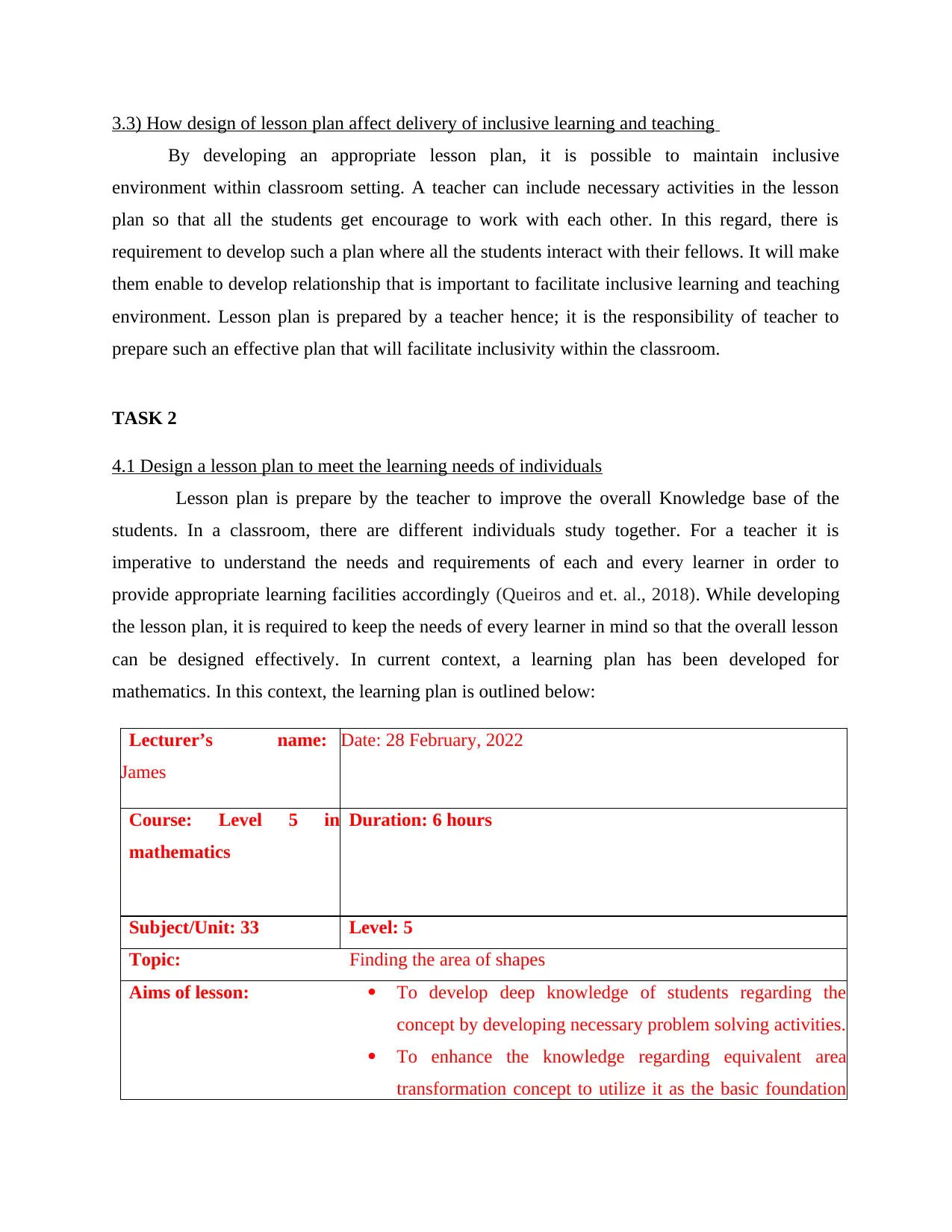
3.3) How design of lesson plan affect delivery of inclusive learning and teaching
By developing an appropriate lesson plan, it is possible to maintain inclusive
environment within classroom setting. A teacher can include necessary activities in the lesson
plan so that all the students get encourage to work with each other. In this regard, there is
requirement to develop such a plan where all the students interact with their fellows. It will make
them enable to develop relationship that is important to facilitate inclusive learning and teaching
environment. Lesson plan is prepared by a teacher hence; it is the responsibility of teacher to
prepare such an effective plan that will facilitate inclusivity within the classroom.
TASK 2
4.1 Design a lesson plan to meet the learning needs of individuals
Lesson plan is prepare by the teacher to improve the overall Knowledge base of the
students. In a classroom, there are different individuals study together. For a teacher it is
imperative to understand the needs and requirements of each and every learner in order to
provide appropriate learning facilities accordingly (Queiros and et. al., 2018). While developing
the lesson plan, it is required to keep the needs of every learner in mind so that the overall lesson
can be designed effectively. In current context, a learning plan has been developed for
mathematics. In this context, the learning plan is outlined below:
Lecturer’s name:
James
Date: 28 February, 2022
Course: Level 5 in
mathematics
Duration: 6 hours
Subject/Unit: 33 Level: 5
Topic: Finding the area of shapes
Aims of lesson: To develop deep knowledge of students regarding the
concept by developing necessary problem solving activities.
To enhance the knowledge regarding equivalent area
transformation concept to utilize it as the basic foundation
By developing an appropriate lesson plan, it is possible to maintain inclusive
environment within classroom setting. A teacher can include necessary activities in the lesson
plan so that all the students get encourage to work with each other. In this regard, there is
requirement to develop such a plan where all the students interact with their fellows. It will make
them enable to develop relationship that is important to facilitate inclusive learning and teaching
environment. Lesson plan is prepared by a teacher hence; it is the responsibility of teacher to
prepare such an effective plan that will facilitate inclusivity within the classroom.
TASK 2
4.1 Design a lesson plan to meet the learning needs of individuals
Lesson plan is prepare by the teacher to improve the overall Knowledge base of the
students. In a classroom, there are different individuals study together. For a teacher it is
imperative to understand the needs and requirements of each and every learner in order to
provide appropriate learning facilities accordingly (Queiros and et. al., 2018). While developing
the lesson plan, it is required to keep the needs of every learner in mind so that the overall lesson
can be designed effectively. In current context, a learning plan has been developed for
mathematics. In this context, the learning plan is outlined below:
Lecturer’s name:
James
Date: 28 February, 2022
Course: Level 5 in
mathematics
Duration: 6 hours
Subject/Unit: 33 Level: 5
Topic: Finding the area of shapes
Aims of lesson: To develop deep knowledge of students regarding the
concept by developing necessary problem solving activities.
To enhance the knowledge regarding equivalent area
transformation concept to utilize it as the basic foundation
Paraphrase This Document
Need a fresh take? Get an instant paraphrase of this document with our AI Paraphraser
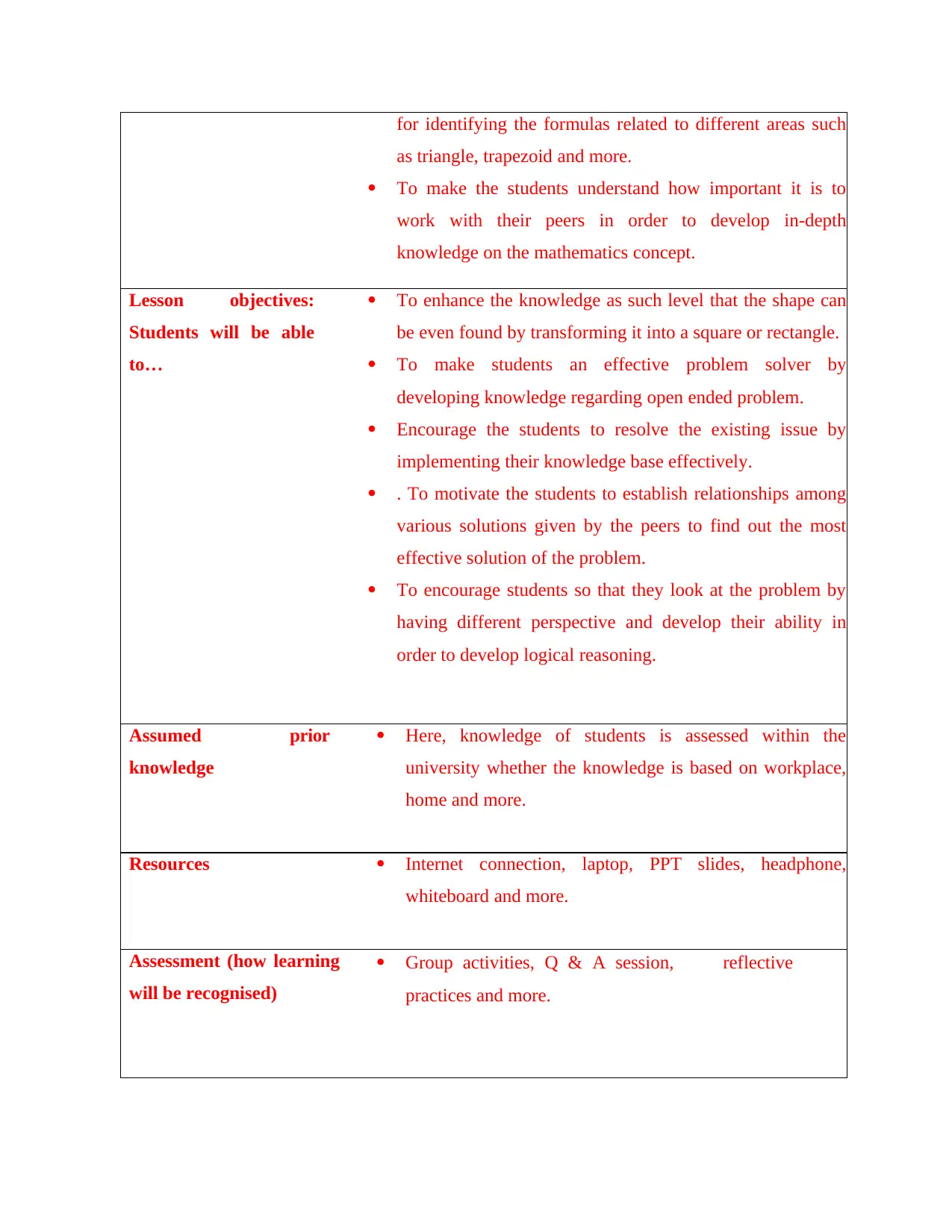
for identifying the formulas related to different areas such
as triangle, trapezoid and more.
To make the students understand how important it is to
work with their peers in order to develop in-depth
knowledge on the mathematics concept.
Lesson objectives:
Students will be able
to…
To enhance the knowledge as such level that the shape can
be even found by transforming it into a square or rectangle.
To make students an effective problem solver by
developing knowledge regarding open ended problem.
Encourage the students to resolve the existing issue by
implementing their knowledge base effectively.
. To motivate the students to establish relationships among
various solutions given by the peers to find out the most
effective solution of the problem.
To encourage students so that they look at the problem by
having different perspective and develop their ability in
order to develop logical reasoning.
Assumed prior
knowledge
Here, knowledge of students is assessed within the
university whether the knowledge is based on workplace,
home and more.
Resources Internet connection, laptop, PPT slides, headphone,
whiteboard and more.
Assessment (how learning
will be recognised)
Group activities, Q & A session, reflective
practices and more.
as triangle, trapezoid and more.
To make the students understand how important it is to
work with their peers in order to develop in-depth
knowledge on the mathematics concept.
Lesson objectives:
Students will be able
to…
To enhance the knowledge as such level that the shape can
be even found by transforming it into a square or rectangle.
To make students an effective problem solver by
developing knowledge regarding open ended problem.
Encourage the students to resolve the existing issue by
implementing their knowledge base effectively.
. To motivate the students to establish relationships among
various solutions given by the peers to find out the most
effective solution of the problem.
To encourage students so that they look at the problem by
having different perspective and develop their ability in
order to develop logical reasoning.
Assumed prior
knowledge
Here, knowledge of students is assessed within the
university whether the knowledge is based on workplace,
home and more.
Resources Internet connection, laptop, PPT slides, headphone,
whiteboard and more.
Assessment (how learning
will be recognised)
Group activities, Q & A session, reflective
practices and more.
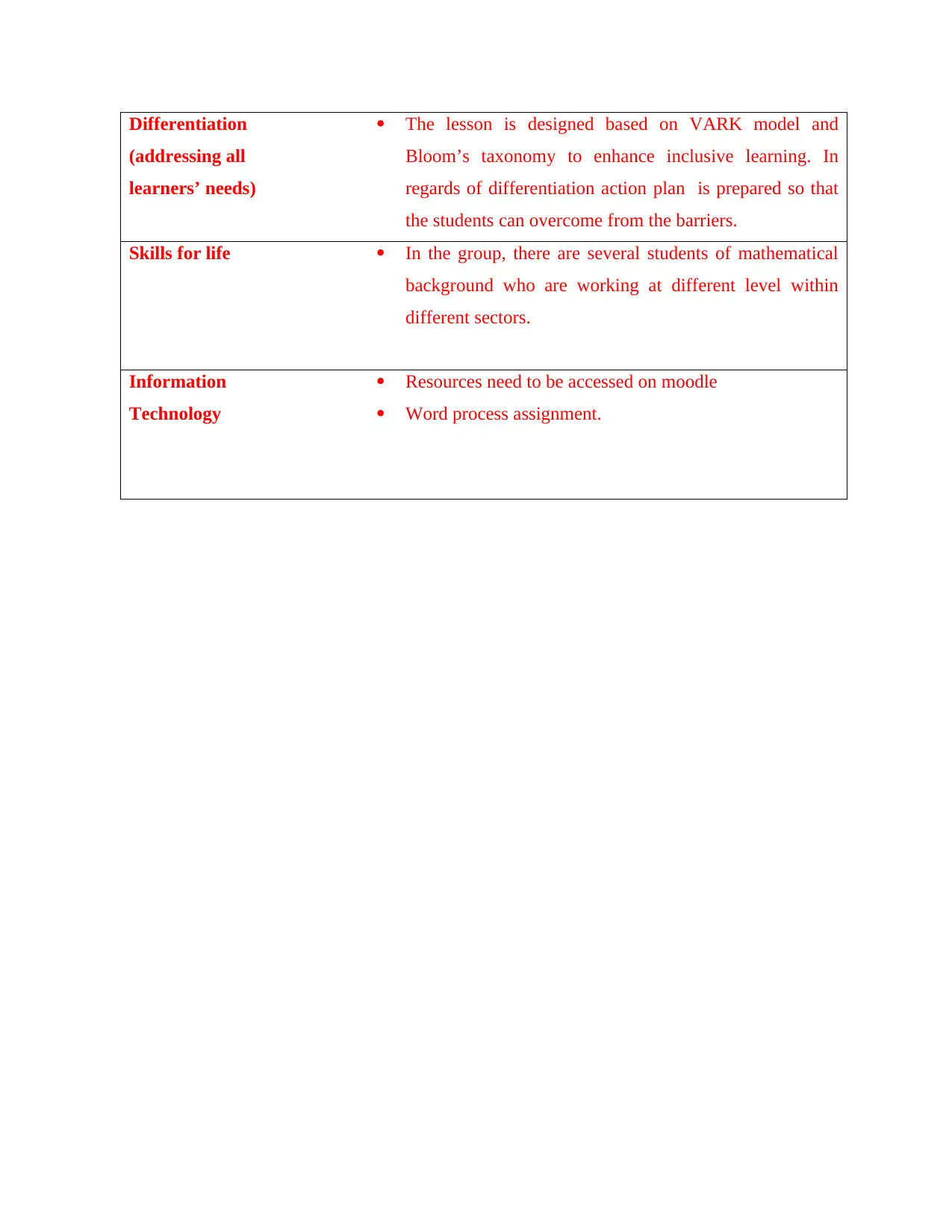
Differentiation
(addressing all
learners’ needs)
The lesson is designed based on VARK model and
Bloom’s taxonomy to enhance inclusive learning. In
regards of differentiation action plan is prepared so that
the students can overcome from the barriers.
Skills for life In the group, there are several students of mathematical
background who are working at different level within
different sectors.
Information
Technology
Resources need to be accessed on moodle
Word process assignment.
(addressing all
learners’ needs)
The lesson is designed based on VARK model and
Bloom’s taxonomy to enhance inclusive learning. In
regards of differentiation action plan is prepared so that
the students can overcome from the barriers.
Skills for life In the group, there are several students of mathematical
background who are working at different level within
different sectors.
Information
Technology
Resources need to be accessed on moodle
Word process assignment.
⊘ This is a preview!⊘
Do you want full access?
Subscribe today to unlock all pages.

Trusted by 1+ million students worldwide
1 out of 24
Related Documents
Your All-in-One AI-Powered Toolkit for Academic Success.
+13062052269
info@desklib.com
Available 24*7 on WhatsApp / Email
![[object Object]](/_next/static/media/star-bottom.7253800d.svg)
Unlock your academic potential
Copyright © 2020–2025 A2Z Services. All Rights Reserved. Developed and managed by ZUCOL.



